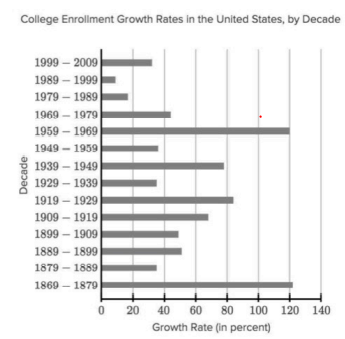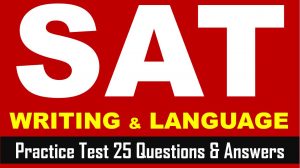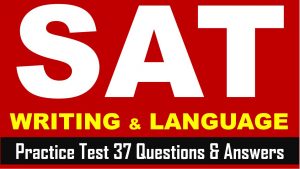Hi SAT Aspirants, welcome to AKVTutorials. As you know SAT (Scholastic Assessment Test) is a standard test, used for taking admission to undergraduate programs of universities or colleges of United States. SAT is developed and published by the College Board, an organization in United States, administered by the Educational Testing Service. Therefore, you need to do practice on SAT Reading Section, SAT Writing and Language Section. In this article, you will get SAT Writing and Language Practice Test 51 with Answer Keys AMBIPi
Instruction:
- In the passage below is accompanied by a number of questions.
- For some questions, you need to think how the passage might be revised to improve the expression of ideas.
- For other questions, you will consider how the passage might be edited to correct errors in sentence structure, usage, or punctuation.
- Some questions will direct you to an underlined portion of a passage.
- Other questions will direct you to a location in a passage or ask you to think about the passage as a whole.
SAT Writing & Language Section Passage
SAT Writing and Language Practice Test Passage Title: GI Bill: A Real American Hero
The Servicemen’s Readjustment Act of 1944, often referred to as the GI Bill, was passed by the federal government to assist US veterans returning home after their service in World War II. It provided various kinds of support, 1 such as support in the form of unemployment benefits and mortgage assistance. The GI Bill is best known, however, for the education and training assistance 2 they provided veterans. By 1956, the bill had enabled nearly eight million veterans to pursue higher education and training opportunities. The resulting influx of students had a dramatic effect on higher education in the United States. 3 This sharp increase primarily took place during the post-war years. In that relatively short time, the GI Bill engendered long-lasting changes in the landscape of US higher education.
Under the provisions of the 1944 GI Bill, veterans received financial support to take academic, technical, or vocational classes. For a variety of reasons—to build on their technical military experience, 4 to support their families, or perhaps to retrain and become competitive in a pre-war professional career—many veterans chose the second or third option. Whether they enrolled in a technical engineering class or a vocational class on auto-repair, 5 they’re overarching objectives were to become employed. According to a survey analysis, veterans returning to the University of Illinois had 6 one “predominating request”: an efficient course of study to prepare for a job.
Many new programs began to emerge in response to the rising demand for job-oriented training and education. For example, a proposal to expand the programs for technical and general education in New York surfaced as early as 7 1944. The State University of New York (SUNY) was subsequently founded in 1948. Massachusetts’ Stonehill College, which 8 has been established in the same year, estimates that veterans comprised up to a third of its first entering class.
*Rack your brain and you don’t know why. Follow Wechat: satxbs123, she can help you! 9 Some vocational training programs were even created specifically for the benefit of returning veterans. One of the most unique examples in this category is the Culinary Institute of America, founded in 1946 to offer 10 a novel curriculum for learning cooking stuff.
By opening the gates of higher education to veterans, the GI Bill 11 dramatically increased the college enrollment growth rate. The bill is credited with producing 500,000 engineers, 250,000 teachers, 200,000 medical professionals, and 117,000 metal workers. At that time, this was the most highly educated workforce in the country’s history.

SAT Writing and Language Practice Test Questions
Question No 1
Which choice best maintains the sentence pattern already established in the paragraph?
Option A : No Change
Option B : which included these types of support:
Option C : including a variety of assistance in the areas
Option D : including
Answer
Show/Hide Answer
Option D : including
Question No 2
Which of the following options is the most effective?
Option A : No Change
Option B : it
Option C : this
Option D : that
Answer
Show/Hide Answer
Option B : IT
Question No 3
At this point, the writer wants to use accurate and relevant data from the graph to elaborate on the claim made in the previous sentence. Which choice most effectively accomplishes this goal?
Please choose from one of the following options.
Option A : The college enrollment growth rate was at its highest between 1869 and 1879.
Option B : From 1939 to 1949, the college enrollment growth rate jumped to nearly 80 percent from a rate of approximately 35 percent the preceding ten years.
Option C : One of the most dramatic decreases in college enrollment occurred between 1959 and 1969, when the growth rate fell to less than a third of that of the previous decade.
Option D : More students matriculated between 1919 to 1929 than in the post-World War II period.
Answer
Show/Hide Answer
Option B : From 1939 to 1949, the college enrollment growth rate jumped to nearly 80 percent from a rate of approximately 35 percent the preceding ten years.
Question No 4
Which choice results in the most effective transition to the information that follows in the paragraph?
Option A : No Change
Option B : supporting their families
Option C : family support
Option D : they wanted to support families
Answer
Show/Hide Answer
Option A : No Change
Question No 5
Which choice best maintains the sentence pattern already established in the paragraph?
Option A : No Change
Option B : their
Option C : there
Option D : they are
Answer
Show/Hide Answer
Option B : their
Question No 6
Which choice best maintains the sentence pattern already established in the paragraph?
Option A : No Change
Option B : one, “predominating request”:
Option C : one, “predominating request”;
Option D : one “predominating request”;
Answer
Show/Hide Answer
Option A : No Change
Question No 7
Which choice best maintains the sentence pattern already established in the paragraph?
Option A : 1944, because the
Option B : 1944, whereas the
Option C : 1944; the
Option D : 1944; however, the
Answer
Show/Hide Answer
Option C : 1944; the
Question No 8
The writer is considering deleting the underlined sentence. Should the sentence be kept or deleted?
Option A : NO CHANGE
Option B : will be
Option C : is
Option D : was
Answer
Show/Hide Answer
Option D : was
Question No 9
Which choice provides the most effective transition at this point?
Option A : No Change
Option B : Eventually, these numbers would taper off.
Option C : Nevertheless, the GI Bill had a long-lasting impact on the demographics of higher education.
Option D : Nor were these figures unique to one college.
Answer
Show/Hide Answer
Option A : No Change
Question No 10
Which choice best maintains the sentence pattern already established in the paragraph?
Option A : No Change
Option B : a new bunch of courses in the culinary arts.
Option C : an unprecedented curriculum in the culinary arts.
Option D : a never-been-done-before batch of classes on cooking.
Answer
Show/Hide Answer
Option C : an unprecedented curriculum in the culinary arts.
Question No 11
Which choice most effectively asserts the claim supported by the rest of paragraph?
Option A : No Change
Option B : eased the transition for the millions of veterans returning home after their military service.
Option C : shaped not only colleges and training programs but also the workforce as a whole.
Option D : transformed the demographics of colleges all over the United States.
Answer
Show/Hide Answer
Option C : shaped not only colleges and training programs but also the workforce as a whole.



